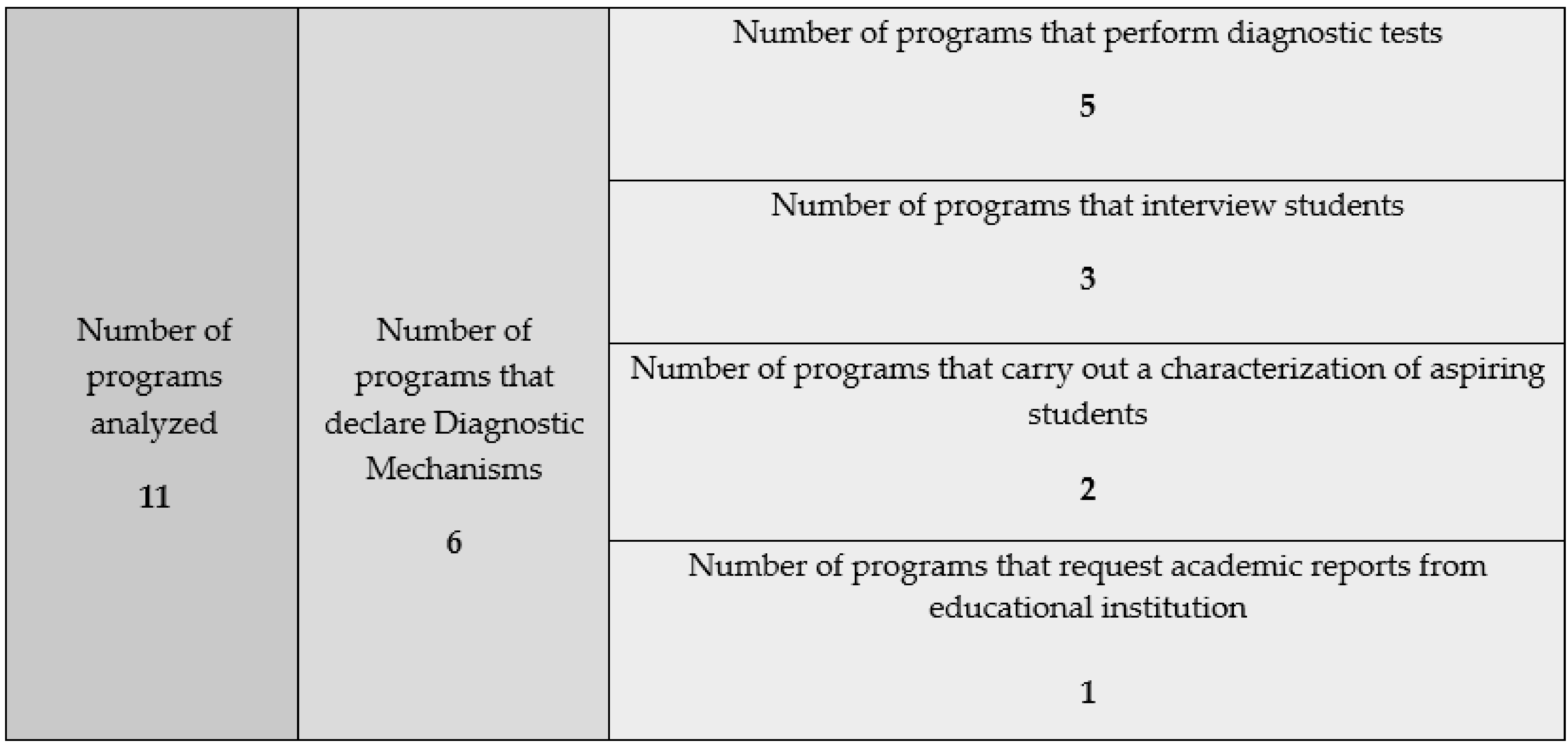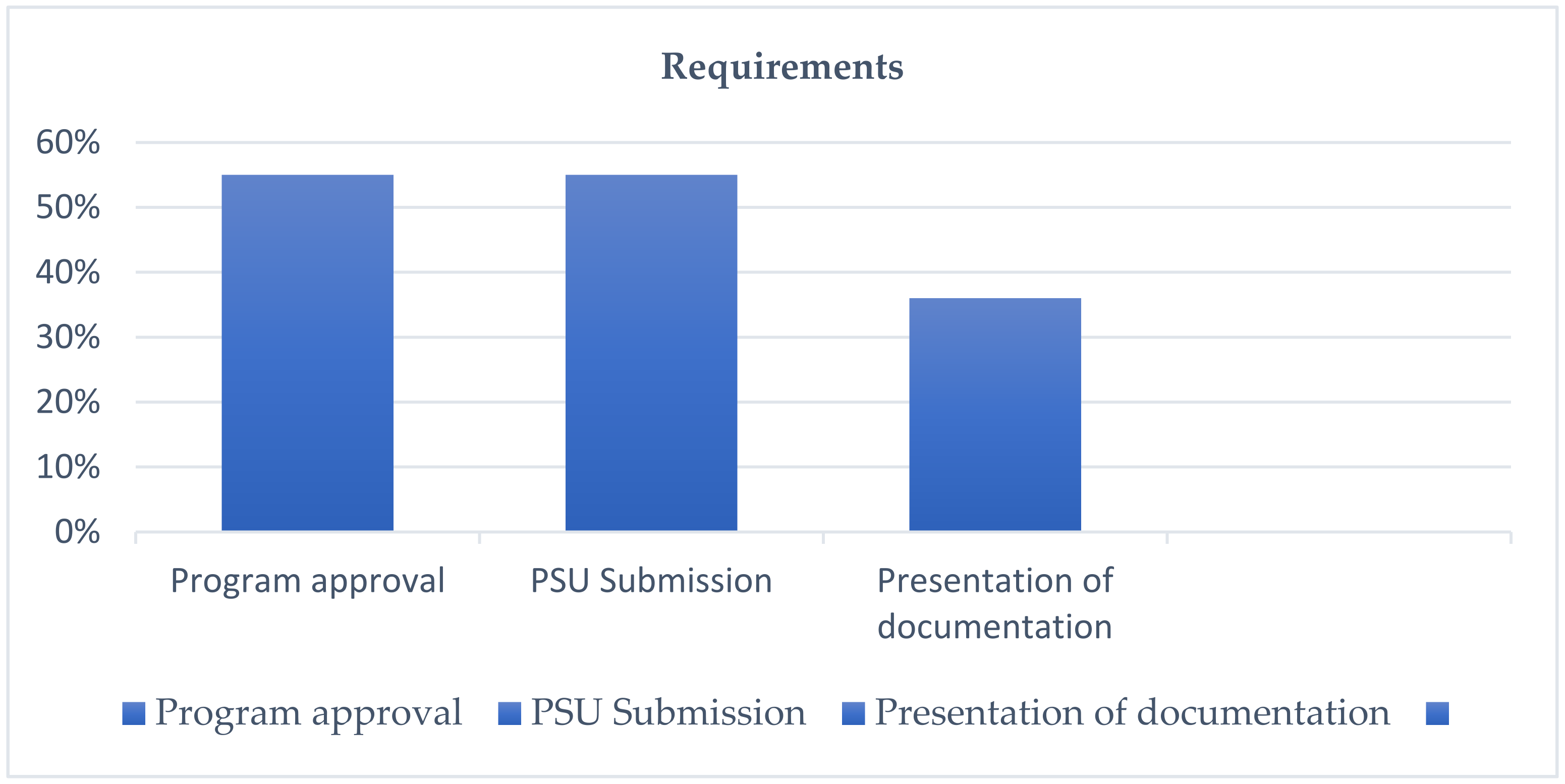Programs of Access to Pedagogy: Diagnostic of Its Design in Chilean Private Universities
Abstract
:1. Introduction
Theoretical Framework
2. Materials and Methods
3. Results and Discussion
3.1. Objectives of the Program
3.2. Admission
3.3. Diagnostic Mechanisms
3.4. Preparation Activities and Modules
3.5. Management Models
3.6. Graduation and Enrolment of Students at the University
3.7. Accompaniment Systems
3.8. Program Dissemination Mechanism
3.9. Accompaniment of Students at FID
3.10. Practical Implications
3.11. Future Directions
3.12. Limitations
4. Conclusions
Author Contributions
Funding
Informed Consent Statement
Data Availability Statement
Acknowledgments
Conflicts of Interest
References
- Alvarado, M.; Cabezas, G.; Folck, D.; Ortega, M. La Evaluación Docente y sus Instrumentos: Discriminación del Desempeño Docente y Asociación con los Resultados de los Estudiantes. Centro de Estudios, Ministerio de Educación, Chile, 2012. Available online: https://bibliotecadigital.mineduc.cl/handle/20.500.12365/18283 (accessed on 20 November 2021).
- Hattie, J. The Black Box of Tertiary Assessment: An Impending Revolution. In Tertiary Assessment & Higher Education Student Outcomes: Policy, Practice & Research; Meyer, L.H., Davidson, S., Anderson, H., Fletcher, R., Johnston, P.M., Rees, M., Eds.; Ako Aotearoa: Wellington, New Zealand, 2009; pp. 259–275. Available online: http://citeseerx.ist.psu.edu/viewdoc/download?doi=10.1.1.544.4214&rep=rep1&type=pdf (accessed on 20 November 2021).
- McKenzie, P.; Santiago, P. Teachers Matter. Attracting, Developing and Retaining Effective Teachers; OECD: Paris, Francia, 2005. [Google Scholar]
- Contreras, M. Educar en Tiempos de Pandemia: Acentuación de las Desigualdades en el Sistema Educativo Chileno. Caminhos Educ. Diálogos Cult. Divers. 2020, 2, 43–68. Available online: https://revistas.ufpi.br/index.php/cedsd/article/view/11241/pdf (accessed on 21 November 2021).
- BCN. Ley 19961 Sobre Evaluación Docente. Available online: https://www.bcn.cl/leychile/navegar?idNorma=228943 (accessed on 15 October 2021).
- BCN. Ley 20129 Establece un Sistema Nacional de Aseguramiento de la Calidad de la Educación Superior. Available online: https://www.bcn.cl/leychile/navegar?idNorma=255323 (accessed on 15 October 2021).
- BCN. Ley 20903 Crea el Sistema de Desarrollo Profesional Docente y Modifica Otras Normas. Available online: https://www.bcn.cl/leychile/navegar?idNorma=1087343 (accessed on 15 October 2021).
- Donoso, F.; Ruffinelli, A. ¿Hacia una Formación Inicial Docente de Calidad?: La Evaluación Nacional Diagnóstica en las Voces de Actores Partícipes del Proceso de Redacción e Implementación de la Ley 20.903. Rev. Estud. Exp. En Educ. 2020, 19, 125–147. [Google Scholar] [CrossRef]
- Hormazábal González, N.; Abricot Marchant, N.; Oyarzo Vargas, K.; Alvarado Arteaga, M.; Bravo Tobar, C. Programas de Acceso Especial a las Carreras de Pedagogía: Sus Características en las Universidades del Estado de Chile. Sophia Austral 2020, 25, 93–119. [Google Scholar] [CrossRef]
- Ministerio de Educación. Requisitos de Acreditación para Carreras y Programas Regulares de Pedagogía en el Marco de la Ley N° 20.129 y sus Modificaciones por la Ley N° 20.903: Condiciones de Admisión Universitaria y Programas de Preparación y Acceso de Estudiantes de Educación Media para Continuar Estudios de Pedagogía, 2006. Available online: http://dfi.mineduc.cl/usuarios/MECESUP/File/2016/eventos/FIP/7sept2016/FID07Sep2016-pres.pdf (accessed on 20 November 2021).
- Elgueta, M.Q.; Reyes, R.C.; Maldonado, A.R.; Herrera, C.; Pérez, C. Contexto y desafíos en Formación de profesores, Universidad de Los Lagos, Chile. Opción Rev. Cienc. Hum. Soc. 2018, 86, 450–480. Available online: https://dialnet.unirioja.es/servlet/articulo?codigo=7338182 (accessed on 15 October 2021).
- Darling-Hammond, L. The Flat World and Education; Teachers College Press: New York, NY, USA, 2010. [Google Scholar]
- García-Huidobro, J. La Política Docente hoy y la Formación de Profesores. Docencia 2011, 43, 12–22. Available online: http://revistadocencia.cl/sitio/wp-content/uploads/2021/12/Docencia_43.pdf (accessed on 15 October 2021).
- BCN. Ley 20529 Sistema Nacional de Aseguramiento de la Calidad de la Educación Parvularia, Básica y Media y su Fiscalización. Available online: https://www.bcn.cl/leychile/navegar?idNorma=1028635 (accessed on 15 October 2021).
- Avalos, B. La Formación Inicial Docente en Chile: Tensiones Entre Políticas de Apoyo y Control. Estud. Pedagóg. 2014, 40, 11–28. [Google Scholar] [CrossRef]
- Cabezas, V. Desafíos y Tensiones Entre las Nuevas Políticas Educativas y los Programas de Formación Inicial de Profesores en Chile; (P.U. Católica) Temas de la Agenda Pública: Santiago, Chile, 2019; Volume 14, Available online: https://politicaspublicas.uc.cl/wp-content/uploads/2019/10/Paper-serie-Temas-de-la-Agenda-Pu%CC%81blica-N%C2%B0-116-2.pdf (accessed on 20 October 2021).
- Real Academia Española (RAE). Calidad. 2021. Available online: https://dle.rae.es/calidad#6nVpk8P (accessed on 10 March 2022).
- Vásquez, A. Calidad y Calidad Educativa; Investigación Educativa: Lima, Perú, 2013; Volume 17, pp. 49–71. Available online: http://disde.minedu.gob.pe/handle/20.500.12799/2945 (accessed on 10 March 2022).
- Aziz, C. Evolución e Implementación de las Políticas Educativas en Chile. Nota Técnica, 2018, Volume 2. Available online: https://www.lidereseducativos.cl/wp-content/uploads/2018/06/NT2_L6_C.A_Evolucio%CC%81n-e-implementacio%CC%81n-de-las-poli%CC%81ticas-educativas-en-Chile.pdf (accessed on 20 October 2021).
- Vaillant, D.E.; Marcelo, C. Ensinando a Ensinar: As Quatro Etapas de uma Aprendizagem. Universidade Tecnologica Federal de Paraná. 2012. Available online: https://idus.us.es/handle/11441/29171 (accessed on 20 October 2021).
- Carrasco-Aguilar, C.; Figueroa, M. Formación Inicial Docente y High Staker Accountability: El Caso de Chile. Profr. Rev. Currículum Form. Profr. 2019, 23, 91. [Google Scholar] [CrossRef]
- Vanegas, C.; Fuentealba, A. Identidad Profesional Docente, Reflexión y Práctica Pedagógica: Consideraciones Claves Para la Formación de Profesores. Perspect. Educ. Form. Profr. 2019, 58, 115–138. [Google Scholar] [CrossRef]
- Vaillant, D. Formación Inicial del Profesorado en América Latina: Dilemas Centrales y Perspectivas. Rev. Española De Educ. Comp. 2013, 22, 185–206. [Google Scholar] [CrossRef] [Green Version]
- Arias, P.; Villarroel, T. Radiografía a las Carreras de Pedagogía y Propuestas Para Maximizar el Impacto de la ley de Desarrollo Profesional Docente. Chile, 2019. Available online: https://accioneducar.cl/wp-content/uploads/2019/12/Radiograf%C3%ADa-a-las-carreras-de-Pedagog%C3%ADa-y-propuestas-para-maximizar-el-impacto-de-la-Ley-de-Desarrollo-Profesional-Docente.pdf (accessed on 25 October 2021).
- Contreras-Arellano, J.; Sandoval-Vidal, H.; González-Osorio, L.A. Relación entre Perfil de Ingreso y Rendimiento Académico Línea Curricular Morfofunción. Int. J. Odontostomatol. 2020, 14, 417–423. [Google Scholar] [CrossRef]
- Esteban, F.; Mellén, T. ¿Por qué Quieres ser Maestro?,¿ Cómo es un Buen Maestro? Ideas Para la Formación Universitaria. Bordón 2016, 68, 185–198. Available online: http://diposit.ub.edu/dspace/bitstream/2445/116631/1/667153.pdf (accessed on 12 March 2022). [CrossRef] [Green Version]
- García, R.S.; Fonseca, C.D. Ser un Buen Profesor. Una Mirada Desde Dentro. Edetania. Estud. Propues. Socioeducativos 2016, 50, 191–208. Available online: https://revistas.ucv.es/index.php/Edetania/article/view/27 (accessed on 12 March 2022).
- Muñoz, V.; De Pedro, F. Educar Para la Resiliencia. Un Cambio de Mirada en la Prevención de Situaciones de Riesgo Social. Rev. Complut. Educ. 2005, 16, 107–124. Available online: https://revistas.ucm.es/index.php/RCED/article/download/RCED0505120107A/16059 (accessed on 12 March 2022).
- Valdivieso, S.; Ayuste, A.; Rodríguez, M.; Vila, E. Educación y género en la formación docente en un enfoque de equidad y democracia. In Democracia y Educación en la Formación Docente; Servei de Publicacions de la Universitat de Vic-Universitat Central de Catalunya: Barcelona, Spain, 2016; pp. 117–140. Available online: https://dialnet.unirioja.es/servlet/articulo?codigo=5783797 (accessed on 12 March 2022).
- Hernández-Ayala, H.; Tobón-Tobón, S. Análisis Documental del Proceso de Inclusión en la Educación. Ra Ximhai 2016, 12, 399–420. Available online: http://www.revistas.unam.mx/index.php/rxm/article/view/71898 (accessed on 15 October 2021). [CrossRef]
- Dulzaides, M.; Molina, A. Análisis Documental y de Información: Dos Componentes de un Mismo Proceso. Acimed 2004, 12, 1. Available online: http://scielo.sld.cu/scielo.php?script=sci_arttext&pid=S1024-94352004000200011 (accessed on 15 October 2021).
- Cáceres, R.; Azema, C.A.J. Autopercepción de Estudiantes Novatos de Pedagogías Relativa a la Vocación y Talento Pedagógico. Rev. Reflexión Investig. Educ. 2018, 1, 33–56. Available online: http://revistas.ubiobio.cl/index.php/REINED/article/view/3404 (accessed on 1 October 2021).
- Walker-Janzen, W.; González-García, G.; García-Olguín, R. Características Socio Académicas de Estudiantes en Chile Postulados con Talento Escolar Para la Pedagogía. Educ. E Pesqui. 2020, 46, 1–18. [Google Scholar] [CrossRef]
- Bellei, C.; Valenzuela, J.P. ¿Están las Condiciones Para que la Docencia sea una Profesión de Alto Estatus en Chile? En S. Martinic y G. Elacqua (editores) Fin de Ciclo: Cambios en la Gobernanza del Sistema Educativo. Facultad de Educación; Pontificia Universidad Católica de Chile y Oficina Regional para América Latina y el Caribe UNESCO: Santiago, Chile, 2010. [Google Scholar]
- Salvatierra, Á.; Gallarday, S.; Ocaña-Fernández, Y.; Palacios, J. Caracterización de las Habilidades del Razonamiento Matemático en Niños con TDAH. Propósitos Represent. 2019, 1, 165–184. [Google Scholar] [CrossRef]
- Baquero, D.; Cárdenas, S. Transversal Skills, Personal and Professional Development in Teaching through Habilitic Platform; Revista Conrado: Cienfuegos, Cuba, 2019; Volume 15, pp. 421–428. Available online: http://scielo.sld.cu/pdf/rc/v15n70/1990-8644-rc-15-70-421.pdf (accessed on 20 October 2021).
- Koyanagi, Y.; Aung, M.N.; Yuasa, M.; Sekine, M.; Takao, O. The relationship between social capital and students’ academic motivation: A study of health professional education in Japan. Eur. J. Investig. Health Psychol. Educ. 2021, 11, 129–141. [Google Scholar] [CrossRef]
- Gillies, R.M. Dialogic teaching during cooperative in-quiry-based science: A case study of a Year 6 classroom. Educ. Sci. 2020, 10, 328. [Google Scholar] [CrossRef]
- González, J.; Herrera, Y.; Núñez, K.; Araya, C.; Carvajal, C.; Pérez, J.; Sessarego, I.; Ávila, P.; Plaza, R.; López, J. Modelos Universitarios en Chile: Elementos Basales Para su Formulación en Tiempos de Incertidumbre y Liquidez, 1st ed.; Universidad de Playa Ancha: Valparaíso, Chile, 2022. [Google Scholar]
- Puerta, C. El Acompañamiento Educativo Como Estrategia de Cercanía Impulsadora del Aprendizaje del Estudiante. Rev. Virtual Univ. Católica Norte 2016, 49, 1–6. Available online: https://www.redalyc.org/pdf/1942/194247574001.pdf (accessed on 15 October 2021).
- Villena, N.; Villegas, C.; Castillo-Paredes, A. Programas de acceso de pedagogía, ¿Una opción para estudiar Educación Física? J. Mov. Health 2021, 19, 1–3. [Google Scholar] [CrossRef]
- Garcia-Ros, R.; Pérez-Gonzalez, F.; Castillo Fuentes, M.; Cavas-Martínez, F. Prediction of first-year university student retention: Validation of the university persis-tence questionnaire in a Spanish sample. Sustainability 2019, 11, 4425. [Google Scholar] [CrossRef] [Green Version]
- Castañeda, M.; Arévalo, R.; Concha, C.; Castañeda, P. Contribución de la Vinculación con el Medio de las Universidades Públicas Regionales al Desarrollo de la Región de Valparaíso, Chile. Educ. Super. 2021, 8, 27–38. Available online: http://www.scielo.org.bo/pdf/escepies/v8n2/v8n2_a06.pdf (accessed on 20 October 2021). [CrossRef]
- Colomo, E. ¿Cómo se Educa Para ser Feliz? El Papel del Maestro en el Desarrollo del Alumno. Cuest. Pedagóg. 2015, 24, 59–73. Available online: https://core.ac.uk/download/pdf/51410772.pdf (accessed on 10 March 2022).
- Izquierdo, B. El compromiso y liderazgo de los grupos de investigación relacionado con la política pública en educación. Su impacto en las sociedades públicas y del conocimiento. In Educación y Transformación Social y Cultural; Larragueta, M., Ceballos, I., Eds.; Editorial Universitas S.A.: Madrid, Spain, 2019; Available online: https://dialnet.unirioja.es/servlet/articulo?codigo=6933636 (accessed on 15 October 2021).


| Analytical Criteria | Categories |
|---|---|
| Objectives of the Program |
|
| Admission |
|
| Diagnostic Mechanisms |
|
| Activities and Preparation Modules |
|
| Management Model |
|
| Graduation and Enrollment of Students in the University |
|
| Accompaniment Systems |
|
| Program Dissemination Mechanisms |
|
| Accompaniment of Students at FID |
|
| Categories | Frequencies |
|---|---|
| Skills development | 8 |
| Personal development | 3 |
| Pedagogical vocation | 10 |
| Equity promotion | 10 |
| Accompaniment | 5 |
| Improving the quality of education | 3 |
| Categories | Frequencies |
|---|---|
| Recommendation of the establishment | 2 |
| Interest in pedagogy | 5 |
| Interviews | 4 |
| Academic performance | 8 |
| Agreements with the institution | 1 |
| Participation in artistic activities | 1 |
| Commitment to the program | 4 |
| Categories | Frequencies |
|---|---|
| Academic support | 11 |
| Psychological support | 6 |
| Support in the integration to university life | 4 |
| Application of diagnoses | 4 |
Publisher’s Note: MDPI stays neutral with regard to jurisdictional claims in published maps and institutional affiliations. |
© 2022 by the authors. Licensee MDPI, Basel, Switzerland. This article is an open access article distributed under the terms and conditions of the Creative Commons Attribution (CC BY) license (https://creativecommons.org/licenses/by/4.0/).
Share and Cite
Núñez-Valdés, K.; Villena Olivares, N.; Villegas Dianta, C.; López Núñez, M.; Castillo-Paredes, A. Programs of Access to Pedagogy: Diagnostic of Its Design in Chilean Private Universities. Eur. J. Investig. Health Psychol. Educ. 2022, 12, 347-362. https://doi.org/10.3390/ejihpe12040026
Núñez-Valdés K, Villena Olivares N, Villegas Dianta C, López Núñez M, Castillo-Paredes A. Programs of Access to Pedagogy: Diagnostic of Its Design in Chilean Private Universities. European Journal of Investigation in Health, Psychology and Education. 2022; 12(4):347-362. https://doi.org/10.3390/ejihpe12040026
Chicago/Turabian StyleNúñez-Valdés, Karen, Neliot Villena Olivares, Cristian Villegas Dianta, Marisol López Núñez, and Antonio Castillo-Paredes. 2022. "Programs of Access to Pedagogy: Diagnostic of Its Design in Chilean Private Universities" European Journal of Investigation in Health, Psychology and Education 12, no. 4: 347-362. https://doi.org/10.3390/ejihpe12040026
APA StyleNúñez-Valdés, K., Villena Olivares, N., Villegas Dianta, C., López Núñez, M., & Castillo-Paredes, A. (2022). Programs of Access to Pedagogy: Diagnostic of Its Design in Chilean Private Universities. European Journal of Investigation in Health, Psychology and Education, 12(4), 347-362. https://doi.org/10.3390/ejihpe12040026








